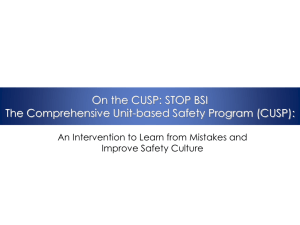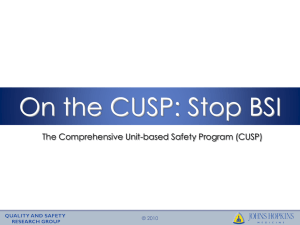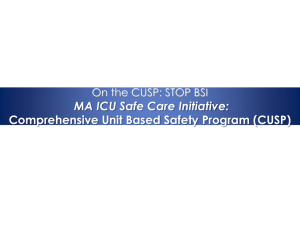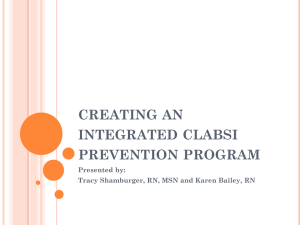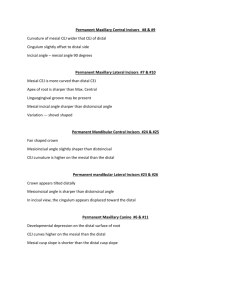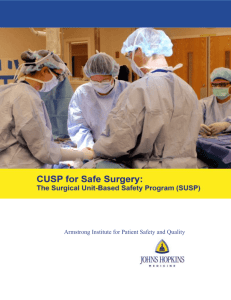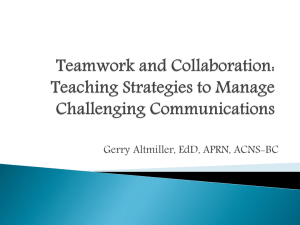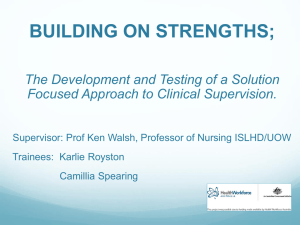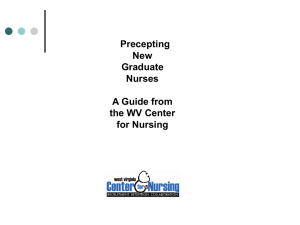Pat Posa, RN, BSN, MSA Joanne Timmel, MSN, RN
advertisement
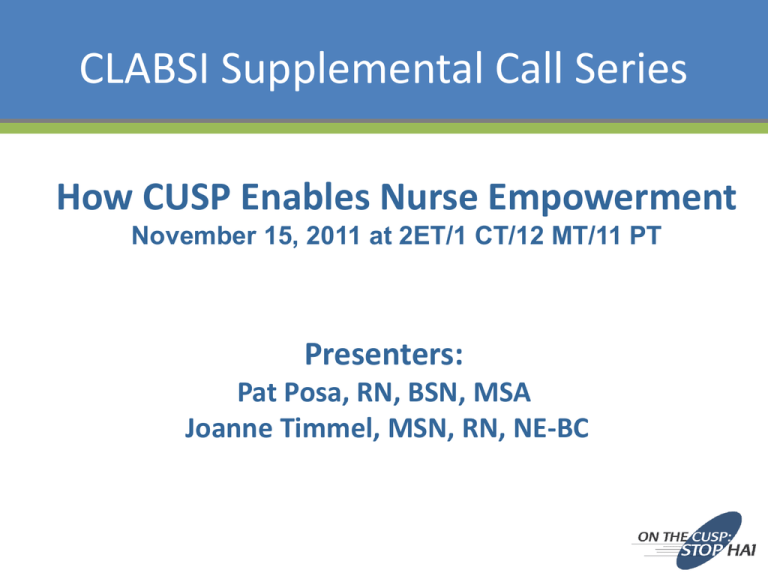
CLABSI Supplemental Call Series How CUSP Enables Nurse Empowerment November 15, 2011 at 2ET/1 CT/12 MT/11 PT Presenters: Pat Posa, RN, BSN, MSA Joanne Timmel, MSN, RN, NE-BC CLABSI Supplemental Call Series Pat Posa, RN, BSN, MSA System Performance Improvement Leader St. Joseph Mercy Heath System Slide 2 Components of CUSP? 1. Form a unit CUSP team with executive sponsorship 2. Measure unit culture 3. Educate staff on Science of Safety 4. Identify defects using the Staff Safety Assessment; prioritize defects 5. Learn from one defect per quarter 6. Implement team/communication tools Slide 3 3 How is CUSP different? It Empowers Nurses in the Hospital • Driven by frontline staff---nurses • CUSP identifies problem areas – – what staff think are impeding patient care vs. what managers/directors think are priority areas • CUSP improvement tools are designed for bedside caregivers – easy for busy staff to use – unit drives its own quality • CUSP can complement other quality improvement methods – must use multiple tools! Slide 4 4 CUSP: St. Joseph Mercy Hospital Journey • Began in 2003 with statewide ICU Collaborative: Keystone ICU • Multidisciplinary Keystone (CUSP) team—meet monthly • Annual assessment of culture—with staff developing action plans to improve culture • Executive rounds • Learn from a defect • Team/Communication tools: – Multidisciplinary rounds with daily goals – Crucial conversation training – Structured Huddles Slide 5 Best Practices: Learning from Defects Tool Slide 6 Best Practices: Engaging & Sustaining Nurse Involvement in CUSP Huddles • Enable teams to have frequent but short briefings so that they can stay informed, review work, make plans, and move ahead rapidly. • Allow fuller participation of front-line staff and bedside caregivers, who often find it impossible to get away for the conventional hour-long improvement team meetings. • They keep momentum going, as teams are able to meet more frequently. Use this strategy to begin to recovery immediately from defects---IE: falls, sepsis and daily to focus on unit outcomes 7 Slide 7 Components Metric 1: Quality/Safety Metric 2: Patient Satisfaction Metric 3: Operations Daily Critical Communications Information Ideas in Motion How to do it? •Beginning or mid shift •5-10 minutes •Lead by member of unit leadership team 8 Slide 8 SICU Huddle Board 9 Slide 9 Surgical Unit Huddle Board Slide 10 Lessons to Bring Home to your Hospitals: Strategies that Promote Nurses & Leverage CUSP • Frontline staff are an integral part of the CUSP team • Meet monthly • Nurses who work in the unit processes everyday are the best people to identify where there are opportunities to improve and how to improve • Allow the nurse to take responsibility for identifying problems and give them a forum and strategy to solve them – CUSP team – Learn from a defect tool – Structured huddles Slide 11 A Healthcare Imperative “In medicine, as in any profession, we must grapple with systems, resources, circumstances, people-and our own shortcomings, as well. We face obstacles of seemingly endless variety. Yet somehow we must advance, we must refine, we must improve.” Atul Gawande, Better: A Surgeon’s Notes on Performance Slide 12 CLABSI Supplemental Call Series Joanne Timmel, MSN, RN, NE-BC Nurse Manager The John Hopkins Hospital Slide 13 Implementing CUSP: Assumptions & Prerequisites • Certain beliefs predispose for success: – Direct care staff are best able to identify impediments to safe efficient care – Staff value patient centered care • Manager has participative leadership style • Setting is important; a room on the unit boosts attendance • Broad Team: Pharmacist, Social Worker, PT & OT, Chaplain, Environmental Services, Mid Level Providers, Residents, Attending, Administrator Slide 14 Implementing CUSP: Engaging the Team • Define CUSP for your setting • Kick off with Science of Safety presentation • Ask the question: “How will the next patient be harmed on our unit?” Slide 15 CUSP: How it Empowers Nurses in the Hospital Nurses are empowered when — • • • • they see change happen their concerns are affirmed they develop a voice and can tell their story they are supported by a unit culture that values speaking up regarding patient safety Nurses are empowered when they actually have power Slide 16 CUSP: Example of Empowerment A surgical unit before CUSP — • Chaos • Unclear plan of care • Very poor communication with the surgeons • Patients frustrated and angry at nurses • Nurses felt powerless. • So they left — high turnover. Slide 17 CUSP: Example of Empowerment Our first CUSP project: • Proposed cohorting • Implemented nurse-physician joint rounds • Developed a written daily goal sheet generated from rounds • Besides rounds, established other mechanisms for non-urgent communication • Continue to articulate new collaborative culture by hosting First Monday breakfasts Slide 18 CUSP: Example of Empowerment Nurses now have a place to address their day to day intransigent system problems • Medications not available when due • Pain control issues in admitted outpatients • Inpatient nurse/ PACU nurse communication • Contributing factors to recent medication errors • New residents lack of familiarity with POE system • Strategies for coverage with decreased resident hours • Pain control issues/ narcotics issues with patients with chronic pancreatitis, Interventional Radiology pts Slide 19 Best Practices: Engaging & Sustaining Nurse Involvement in CUSP • Absolutely requires 3 strong champions (nurse, physician, administration) • Monthly meetings require email reminders, individual invites, reminders throughout day, support to allow staff to step away from pts. • Energy maintained if you focus on what matters to the bedside nurse • Really resolve some problems! Slide 20 Lessons to Bring Home to your Hospitals: Strategies that Promote Nurses with the Leverage of CUSP • If nurses are not engaged in the CUSP process, ask why. • Are you trying to lower CLABSI rate by ultimately requiring nurses to do more, when they know they aren’t able to do half of what they expect of themselves? • Find low hanging fruit (e.g. We need red labels on high concentration PCA) Slide 21 Questions? Slide 22 Your Feedback is Important https://www.surveymonkey.com/s/Z6FJ28T Slide 23
